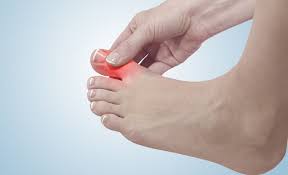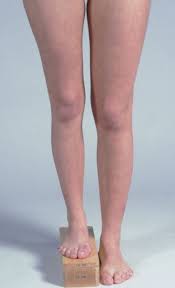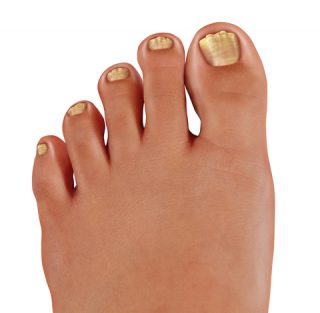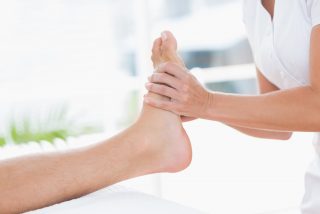
Written by Michelle Champlin BSc Pod., M.Ch.S., S.R., Ch., (UK)
Maybe your Podiatrist or Orthopaedic Surgeon has told you that you have ‘hallux rigidus’? But what exactly does this mean and do you need to do anything to treat it? Chief Podiatrist Michelle Champlin lends us some insight into this toe condition.
What is ‘hallux rigidus’?
Hallux rigidus is the medical name for having a ‘stiff big toe’. Your hallux is your big toe; ‘rigidus’ means ‘stiff.’
Mrs Champlin, Chief Podiatrist at Dubai Podiatry Centre explains: “Every one of us will get some amount of osteoarthritic changes to our bones as we age. This is completely normal and to be expected as we go through adulthood. Hallux rigidus occurs when these arthritic changes occur in the joint of your big toe – what we call the ‘metatarso-phalangeal joint’, to the extent that it can cause symptoms such as pain or stiffness in the joint”. We’ll just call it the MTP joint from now on!
Symptoms of hallux rigidus
• Stiffness and pain in your MTP joint (worse in cold, damp weather and when walking or running)
• Swelling and inflammation around the joint
• Difficulty flexing the joint when you’re walking, squatting etc.
What causes hallux rigidus?
Osteo-arthritic changes happen to all of us as we age. This is the kind of arthritis that is due to normal wear and tear. However, these changes can be worsened in the MTP joint for some of us for the following reasons:
• A foot / ankle biomechanical issue affecting how your foot moves and functions. (Commonly seen in the many of us who over-pronate and/or have lowered medial long arches)
• Inherited from your mum or dad (genetic)
• Increased ongoing stress on the MTP joint from a job or activity that requires a lot of squatting type movement
• An injury to the big toe area – such as stubbing the toe
• An underlying condition such as gout or rheumatoid arthritis.
What happens if I don’t treat it?
Hallux rigidus can worsen over time, causing increasing pain in the MTP joint, even at rest. It can also affect how you walk, causing you to limp. This in turn places more strain on other joints, causing knee, hip or lower backache. You may also develop bone spurs causing irritation to the skin of the area in tight footwear, leading you to buy broader footwear to accommodate.
What can be done to help hallux rigidus?
Seeking advice from a Podiatrist early on is advisable – if you’re in the UAE or travelling through, contact us.
Mrs Champlin advises that “In mild to moderate cases, the symptoms can be alleviated with custom corrective orthotic therapy, worn in your shoes to correct how your foot functions (commonly over-pronation or collapsed long arches). This corrects the underlying cause of the hallux rigidus, and takes weight away from the MTP joint, rather than just superficially treating the pain with steroid injections or anti-inflammatory medication, which will not fix the issue in the long run.”
In more severe cases, surgery by a specialist Orthopaedic Surgeon with expertise in foot surgery may be advised. After surgery (there are different procedures which the surgeon will discuss after consulting with you), the Orthopaedic Surgeon will refer you back to your Podiatrist for a post-surgical custom orthotic to maintain his/her good work in the operating theatre and stop the foot posture reverting, supporting your correct foot posture and alleviating pressure from the MTP joint.
If you are experiencing any pain at all in your big toe joint, you should always seek advice from a Podiatrist without delay. Early intervention is best, and there is always a way forward to reduce or eliminate the pain.
Contact the foot experts at Dubai Podiatry Centre on 04 3435390 for friendly informative diagnosis, explanation and treatment options.
بقلم ميشيل شامبلين
ربما أخبرك طبيب الأقدام أو جراح العظام أنك تعاني من “إبهام القدم الجامد”؟ ولكن ماذا يعني هذا بالضبط وهل تحتاج إلى فعل أي شيء لعلاجه؟ تقدم لنا رئيسة أطباء الأقدام ميشيل شامبلين بعض المعلومات عن حالة إصبع القدم هذه.
ما هو “إبهام القدم الجامد”؟
إبهام القدم الجامد هو الاسم الطبي لوجود “إصبع القدم الكبير المتصلب”. إبهام القدم هو إصبع قدمك الكبير. كلمة “rigidus” تعني “قاسية“.
تشرح السيدة شامبلن، رئيسة أطباء الأقدام في مركز دبي لعلاج الأرجل: “يعاني كل واحد منا من قدر من التغيرات العظمية المفصلية في عظامه مع تقدمنا في العمر. وهذا أمر طبيعي تمامًا ومتوقع مع مرورنا بمرحلة البلوغ. يحدث إبهام القدم الجامد عندما تحدث هذه التغيرات المفصلية في مفصل إصبع قدمك الكبير – ما نسميه “المفصل المشطي السلامي”، إلى الحد الذي يمكن أن يسبب أعراض مثل الألم أو التيبس في المفصل. سوف نسميها فقط MTP مفصل من الآن فصاعدًا!
أعراض إبهام القدم الجامد
• تيبس وألم في المفصل MTP (يزداد سوءًا في الطقس البارد والرطب وعند المشي أو الجري)
• تورم والتهاب حول المفصل
• صعوبة في ثني المفصل أثناء المشي أو الجلوس في وضع القرفصاء وما إلى ذلك.
ما الذي يسبب إبهام القدم الجامد؟
تحدث تغيرات هشاشة العظام والتهاب المفاصل لنا جميعًا مع تقدمنا في العمر. هذا هو نوع التهاب المفاصل الناتج عن البلى الطبيعي. ومع ذلك، يمكن أن تتفاقم هذه التغييرات في المفصل المتوسط المتوسط بالنسبة للبعض منا للأسباب التالية:
• مشكلة ميكانيكية حيوية في القدم/الكاحل تؤثر على كيفية تحرك قدمك ووظائفها. (يُرى بشكل شائع لدى الكثير منا الذين يفرطون في الكب و/أو قاموا بخفض الأقواس الطويلة المتوسطة)
• موروث من والدتك أو والدك (وراثي)
• زيادة الضغط المستمر على المفصل MTP من وظيفة أو نشاط يتطلب الكثير من حركة القرفصاء
• إصابة في منطقة إصبع القدم الكبير – مثل ارتطام إصبع القدم
• حالة كامنة مثل النقرس أو التهاب المفاصل الروماتويدي.
ماذا يحدث إذا لم أعالجه؟
يمكن أن يتفاقم إبهام القدم الجامد بمرور الوقت، مما يسبب ألمًا متزايدًا في المفصل MTP، حتى أثناء الراحة. يمكن أن يؤثر أيضًا على طريقة المشي، مما يسبب لك العرج. وهذا بدوره يضع ضغطًا أكبر على المفاصل الأخرى، مما يسبب آلامًا في الركبة أو الورك أو أسفل الظهر. قد تصاب أيضًا بنتوءات عظمية تسبب تهيجًا لجلد المنطقة عند ارتداء الأحذية الضيقة، مما يدفعك إلى شراء أحذية أوسع لاستيعابها.
ما الذي يمكن فعله لمساعدة إبهام القدم الجامد؟
يُنصح بطلب المشورة من طبيب الأقدام في وقت مبكر – إذا كنت في دولة الإمارات العربية المتحدة أو تسافر عبرها، فاتصل بنا.
تنصح السيدة شامبلن بأنه “في الحالات الخفيفة إلى المتوسطة، يمكن تخفيف الأعراض باستخدام العلاج التقويمي التصحيحي المخصص، الذي يتم ارتداؤه في حذائك لتصحيح كيفية عمل قدمك (عادةً الإفراط في الكب أو الأقواس الطويلة المنهارة). وهذا يصحح السبب الكامن وراء إبهام القدم الجامد، ويقلل الوزن من المفصل MTP، بدلاً من مجرد علاج الألم بشكل سطحي بحقن الستيرويد أو الأدوية المضادة للالتهابات، والتي لن تحل المشكلة على المدى الطويل.
في الحالات الأكثر خطورة، قد يُنصح بإجراء عملية جراحية على يد جراح عظام متخصص يتمتع بخبرة في جراحة القدم. بعد الجراحة (هناك إجراءات مختلفة سيناقشها الجراح بعد التشاور معك)، سيحيلك جراح العظام مرة أخرى إلى طبيب الأقدام للحصول على جهاز تقويم مخصص بعد الجراحة للحفاظ على عمله الجيد في غرفة العمليات وإيقاف القدم إرجاع الوضع، ودعم وضع قدمك الصحيح وتخفيف الضغط من مفصل MTP.
إذا كنت تعاني من أي ألم على الإطلاق في مفصل إصبع قدمك الكبير، فيجب عليك دائمًا طلب المشورة من طبيب الأقدام دون تأخير. التدخل المبكر هو الأفضل، وهناك دائمًا طريقة للمضي قدمًا لتقليل الألم أو القضاء عليه.
اتصل بخبراء القدم في مركز دبي للعناية بالاقدام على الرقم ٠٤٣٤٣٥٣٩٠ للحصول على تشخيص مفيد وشرح وخيارات







